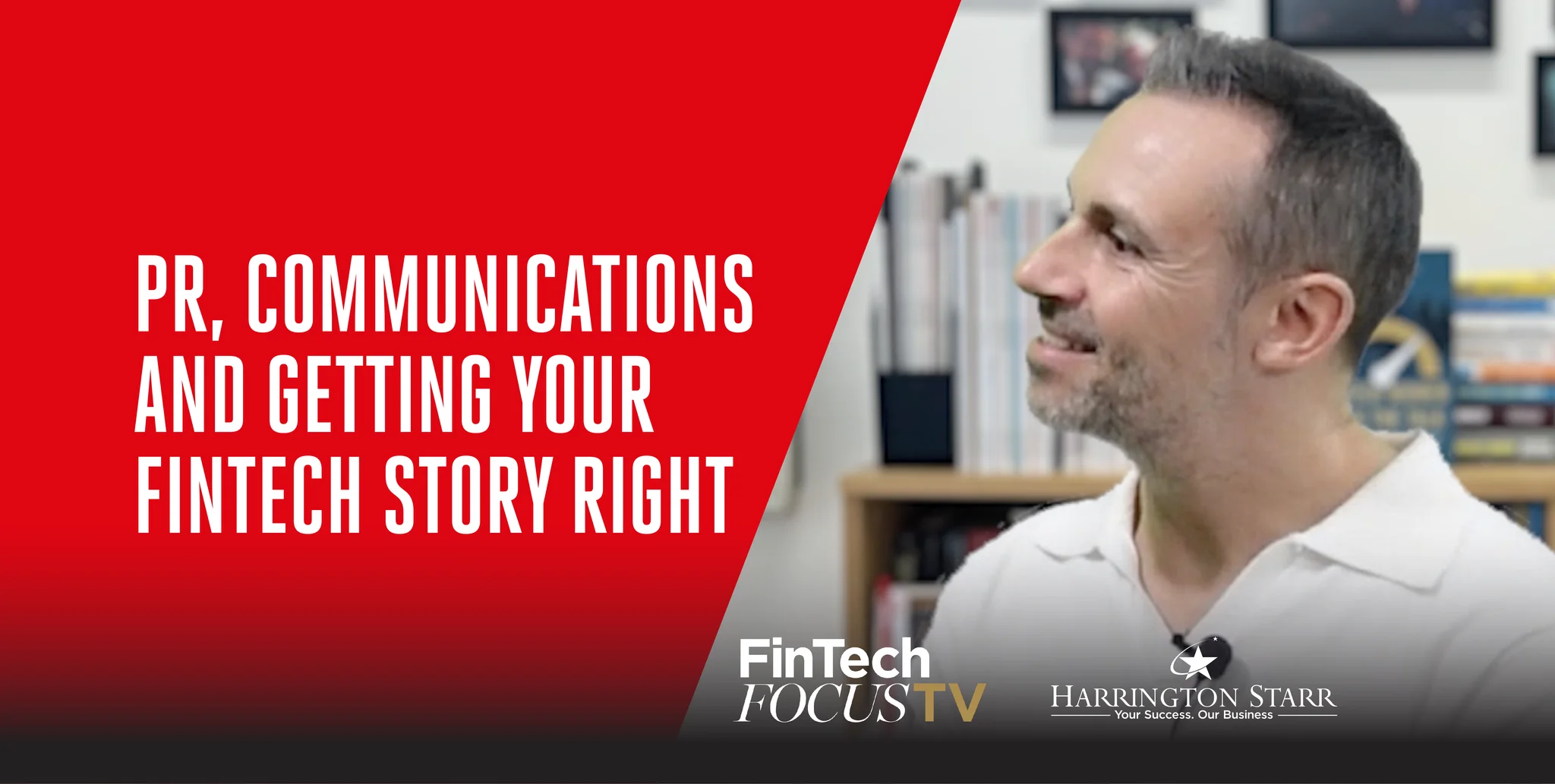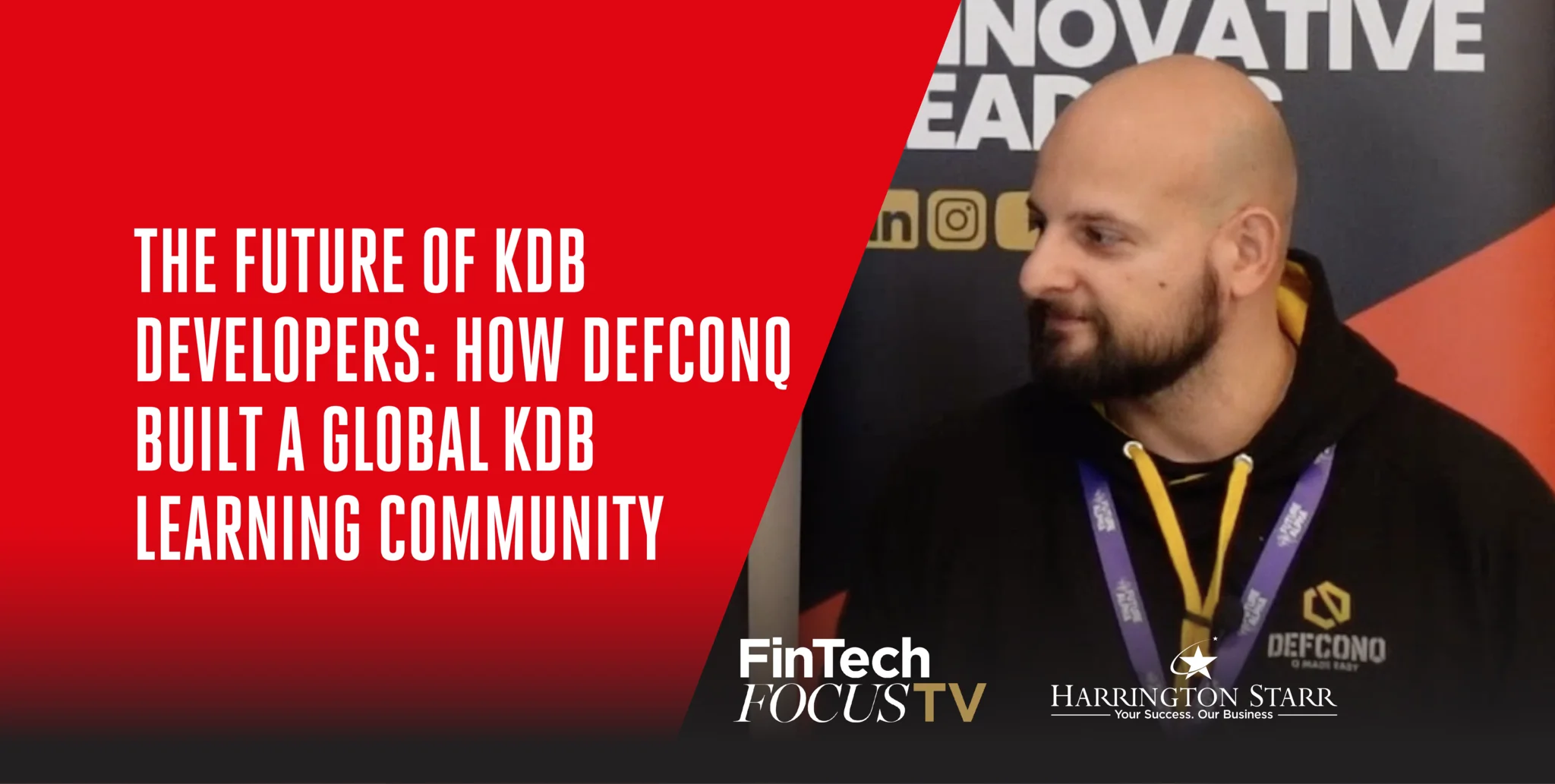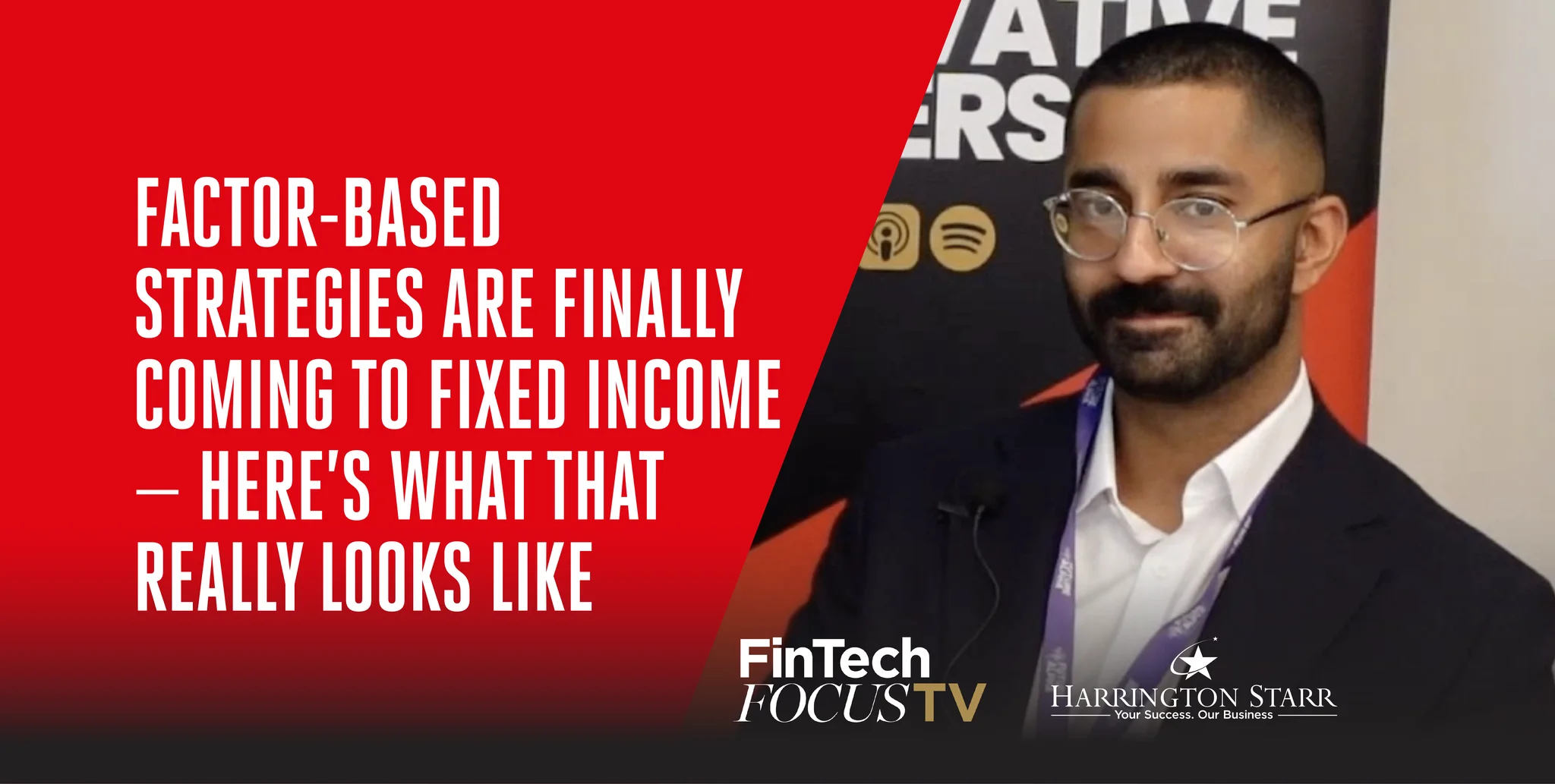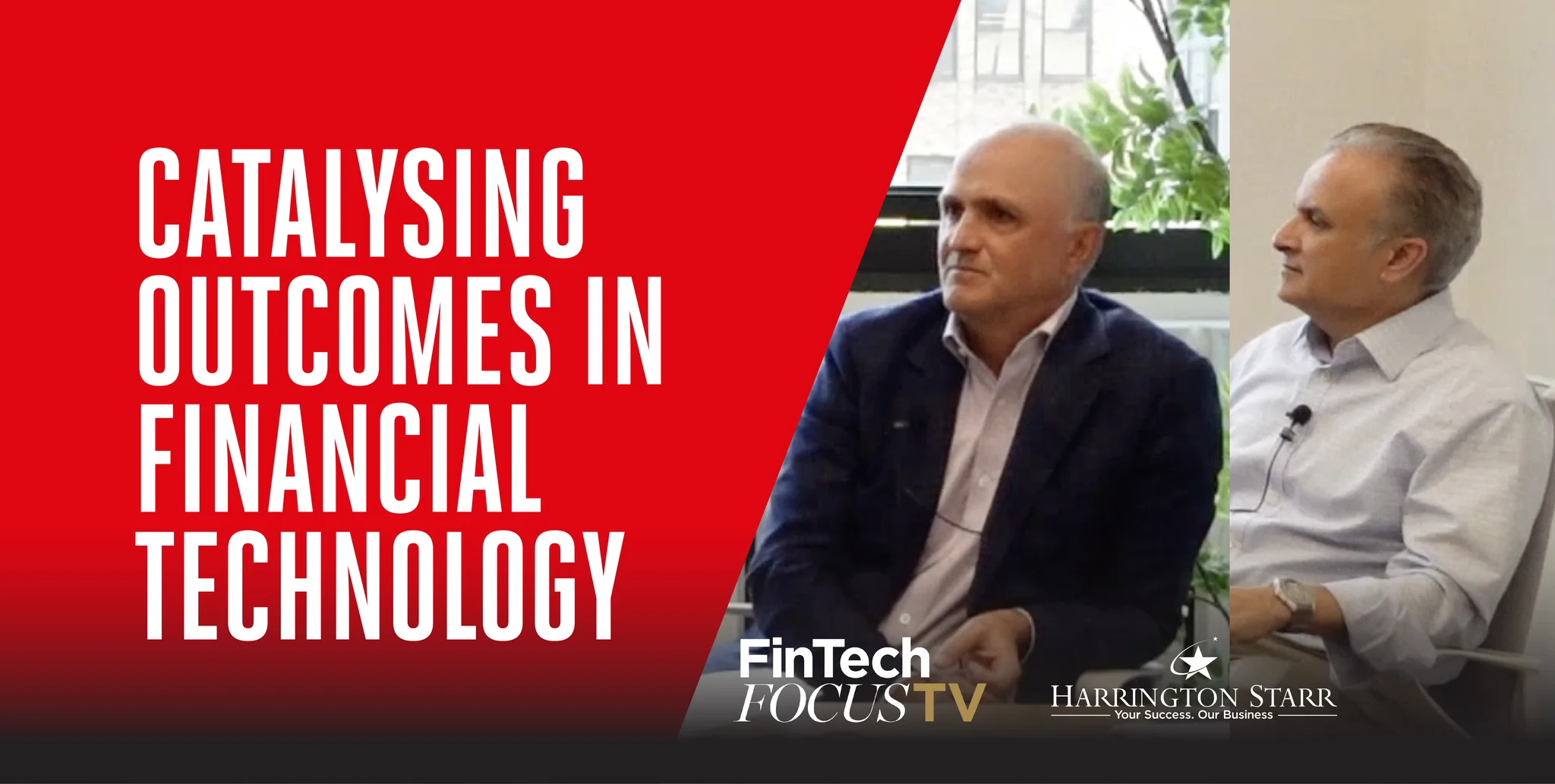How Brand, Communication and Authenticity Drive Growth
In this episode of FinTech Focus TV, Toby, CEO of Harrington Starr, sits down with Paul Bowhay, Senior Vice President and FinTech Lead at Hotwire, to explore the critical role that communication, branding, and storytelling play in the success of FinTech businesses.
With over two decades of experience in communications and marketing, and fifteen years focused specifically on FinTech, Paul has helped shape the reputations of some of the industry’s most influential players. From early disruptors like TransferWise (now Wise) to global powerhouses such as Broadridge, he has seen firsthand how effective storytelling and strategic communication can accelerate business growth.
At a time when FinTechs face an increasingly saturated and fast-moving market, Paul argues that clear, consistent messaging and authentic branding are not just marketing tactics, they are strategic necessities.
Understanding FinTech Through the Lens of Communication
Paul began his career in marketing and communications before specialising in FinTech. Over the last fifteen years, he has guided companies of every size, from innovative startups to established global firms, through complex growth journeys. At Hotwire, he now leads the global FinTech practice, enhancing the agency’s capabilities and helping clients refine their communications strategies, develop market-specific content, and align their messaging with business goals.
As Paul explains, Hotwire is a global communications consultancy that has operated for more than twenty-five years, specialising in technology, consumer tech, and increasingly, FinTech. His role is to bring together his deep industry experience to help FinTech firms communicate more effectively, expand globally, and connect with their audiences in meaningful ways.
The conversation with Toby highlights just how broad and dynamic the FinTech sector has become. From payments and wealth management to RegTech and digital assets, the landscape is constantly evolving, and so are the communication challenges. As Paul notes, payments currently represent one of the most disrupted and competitive areas, but RegTech and WealthTech are also experiencing major innovation.
This variety requires adaptability from communications professionals. For a startup entering a new market, the challenge may be defining a value proposition; for a large global firm, it might be managing risk, reputation, and consistency across regions.
From Startups to Scaleups: How FinTechs Find Their Voice
One of the most striking parts of the discussion is how many FinTech founders underestimate the importance of communication and brand early on. As Paul points out, entrepreneurs often have exceptional technical or product expertise but little understanding of marketing or messaging.
When these founders engage an agency like Hotwire, it’s usually a sign they are ready to professionalise their story. Paul and his team start by asking tough questions: what are your business objectives? Who is your audience? What are your goals for the next six to twelve months? Through this discovery process, they help FinTechs define their identity and communicate it with confidence.
For early-stage companies, this can mean the difference between growth and stagnation. Founders may assume they are unique, but in reality, the FinTech market is crowded with players claiming similar innovation. The challenge, Paul says, is to identify what truly differentiates them, and ensure that message is consistent across every channel.
That means aligning the website, press releases, social media, and spokesperson messaging so they all tell the same story. Inconsistency, he warns, confuses both customers and journalists. The brands that stand out are those that communicate clearly, with a unified voice that reflects their values and purpose.
Why Marketing and PR Are Strategic Growth Drivers
Too many founders still see marketing as “gloss” rather than a growth engine. Toby and Paul agree that this perception is one of the biggest obstacles in the FinTech sector.
Paul argues that communications and marketing do far more than raise awareness, they build reputation, drive revenue, and strengthen relationships. When sales and marketing teams work in silos, opportunities are missed. When they collaborate, however, the business becomes far more powerful.
He recalls how, during COVID-19, marketing became the “superhero” of business. With events cancelled and face-to-face meetings impossible, strong brand presence became the lifeline that kept companies visible and relevant. FinTechs that doubled down on marketing, focusing on thought leadership, storytelling, and community engagement, were the ones that emerged stronger.
For Paul, that period proved a simple truth: brands that communicate value through challenging times earn long-term trust. Those that go quiet risk irrelevance.
The FinTech Brand Challenge: Clarity, Consistency and Authenticity
The conversation moves to the practicalities of building a FinTech brand that resonates. Paul outlines the need for clarity and authenticity at every stage of communication.
FinTech, by nature, is a complex industry. With its heavy use of jargon and technical terms, it’s easy for companies to alienate potential customers. Paul’s advice is to simplify, to speak the language of the customer rather than internal stakeholders.
He stresses that effective messaging starts with understanding the audience: their age, background, and pain points. The goal is to translate complex concepts into simple, human-centred narratives that anyone can understand, from industry insiders to someone with no financial background at all.
As Toby notes, today’s buyers are better informed than ever. In an age of transparency, the old model of selling through charm or vague promises no longer works. Customers research products extensively before engaging, which means companies must ensure that what they say publicly aligns with reality.
For Paul, the best marketing isn’t about creating hype, it’s about building trust through authenticity.
Pivoting with Purpose: How FinTechs Can Adapt Without Losing Their Identity
Toby and Paul discuss how the concept of the “pivot” has evolved. Once seen as a sign of failure, it is now recognised as a hallmark of adaptability.
Paul notes that successful FinTechs are those willing to pause, reassess, and adapt their strategy when market conditions change. Some of his clients review strategy quarterly rather than annually because the pace of change is so intense.
This adaptability extends beyond products and technology, it applies equally to messaging and communication. Brands must be able to evolve their story while maintaining their core identity. As Paul explains, that means reviewing content, testing new narratives, and being transparent when strategies shift.
For FinTech leaders, flexibility in communication is essential. Those who can pivot effectively while maintaining consistency will stay ahead of the curve.
FinTech, AI, and the Future of Marketing
No conversation about modern FinTech is complete without discussing artificial intelligence. Both Toby and Paul agree that AI is transforming the industry, not only in the products FinTechs offer but also in how they market them.
At Hotwire, AI is already a part of daily operations. The team uses AI tools for research, media monitoring, and streamlining repetitive tasks. However, Paul emphasises that AI cannot replace human judgement or creativity.
The risk, he explains, is that if every FinTech uses AI to generate content, the market could become flooded with identical, generic messaging. What will set brands apart is their ability to inject personality, emotion, and expertise, elements that AI cannot replicate.
Paul views AI as an enhancer rather than a replacement. It can speed up certain processes, but it’s the human insight, authenticity, and lived experience that make communications meaningful. Clients come to Hotwire not just for content, but for perspective, the kind of nuanced advice that comes from years of working in the industry.
In an AI-driven world, authenticity becomes even more valuable. Customers and investors can tell when they’re engaging with genuine expertise versus automated content. As Toby points out, personalisation, delivering the right message to the right audience at the right time, has always been key to effective marketing. AI can help refine that process, but it’s human empathy and creativity that give it impact.
The Power of a Clear Story and a Strong USP
One recurring theme in the discussion is the importance of a company’s story and unique selling proposition (USP).
Paul believes few FinTechs truly have a unique product or service, but every company can have a unique story. The key is to define the problem being solved, back it up with evidence, and communicate it with clarity and confidence.
Toby and Paul agree that too many businesses rely on vague descriptors like “cutting-edge” or “innovative.” These words mean little without proof. What investors and customers want are tangible results, time saved, efficiency gained, compliance achieved.
This is where case studies and proof points become invaluable. A well-constructed case study, Paul explains, doesn’t just list results; it tells a story of challenge, action, and outcome, building credibility and trust.
For FinTechs seeking funding, this credibility is vital. Venture capitalists and private equity firms look for strong brands and confident communication as indicators of maturity and leadership.
Becoming a Thought Leader in Financial Technology
The conversation also touches on thought leadership, a term often overused but deeply relevant to FinTech growth.
Paul defines thought leadership as understanding your industry so well that you can contribute valuable, informed perspectives. It’s not about being controversial for attention, it’s about having a clear point of view that adds substance to the conversation.
He advises FinTech leaders to engage with industry developments, share opinions grounded in experience, and be prepared to adapt their message for different audiences. A strong spokesperson knows how to balance confidence with diplomacy, offering insight without alienating potential investors or partners.
As Toby notes, thought leadership and trust are intertwined. The brands that lead conversations, rather than just reacting to them, are the ones that customers and investors gravitate towards.
How FinTech Leaders Can Communicate for Growth
In the latter part of the episode, Toby invites Paul to share practical advice for FinTechs preparing for growth, expansion, or new market entry.
Paul’s guidance is methodical. First, understand your audience, who they are, what challenges they face, and how your product fits into their world. Second, set clear business and communications objectives that align with one another. Third, ensure your strategy is flexible enough to evolve as the market changes.
He also stresses the importance of crisis preparedness. Every FinTech should plan for reputational risk, not just from internal issues, but from partners or clients whose actions might affect their brand.
Finally, he returns to a recurring theme: consistency. Marketing and PR should work hand-in-hand, delivering one coherent message across every channel. And when something isn’t working, be transparent, review, and adapt.
For Paul and Hotwire, success comes from partnership. They don’t just deliver campaigns; they work alongside FinTechs through every stage of their growth journey, helping them evolve and communicate with clarity.
Why Communication Is Central to FinTech Recruitment and Growth
This episode of FinTech Focus TV reinforces a message that resonates deeply with the mission of Harrington Starr: great communication is at the heart of great business.
Just as FinTechs must articulate their brand and story to attract investors and customers, they must also communicate effectively to attract top talent. The same principles apply, clarity, authenticity, and alignment between vision and action.
In recruitment, as in marketing, people respond to purpose. Candidates want to work for companies that know who they are, what they stand for, and where they are going. Businesses that invest in brand and storytelling not only win customers but also the best people in the market.
As the financial technology sector continues to evolve at pace, driven by innovation, regulation, and AI, the ability to communicate with purpose will define the next generation of FinTech leaders.
Conclusion: Building FinTech Brands That Last
Throughout this episode, Paul Bowhay emphasises one central truth: in FinTech, technology may drive innovation, but communication drives connection.
From startups seeking seed funding to global enterprises expanding into new regions, the ability to tell a clear, authentic story determines whether a brand resonates or disappears into the noise. Marketing, PR, and communications are not peripheral, they are strategic tools that fuel growth, attract investors, and inspire trust.
As Toby Babb and Harrington Starr continue to showcase leaders shaping the future of financial technology, conversations like this serve as powerful reminders that the human side of FinTech, storytelling, authenticity, and collaboration, remains its greatest strength.






